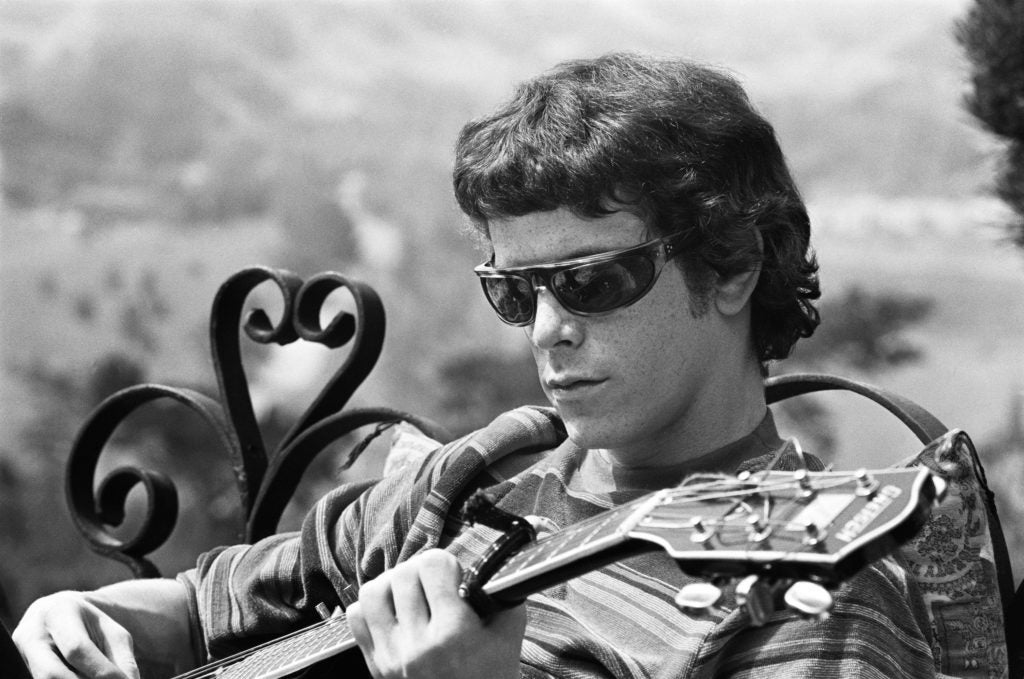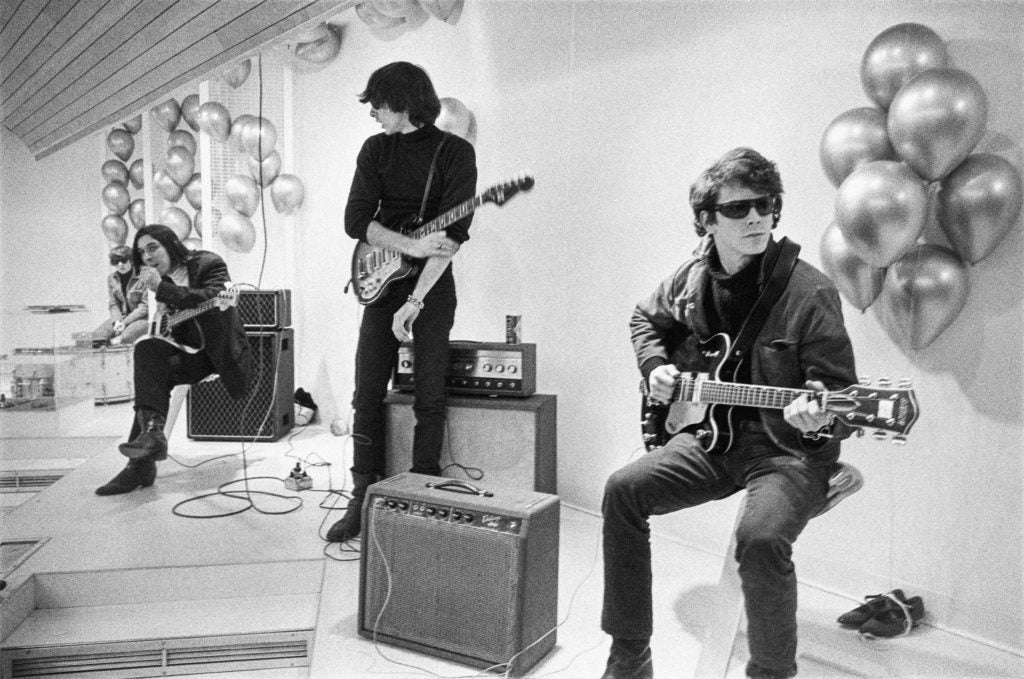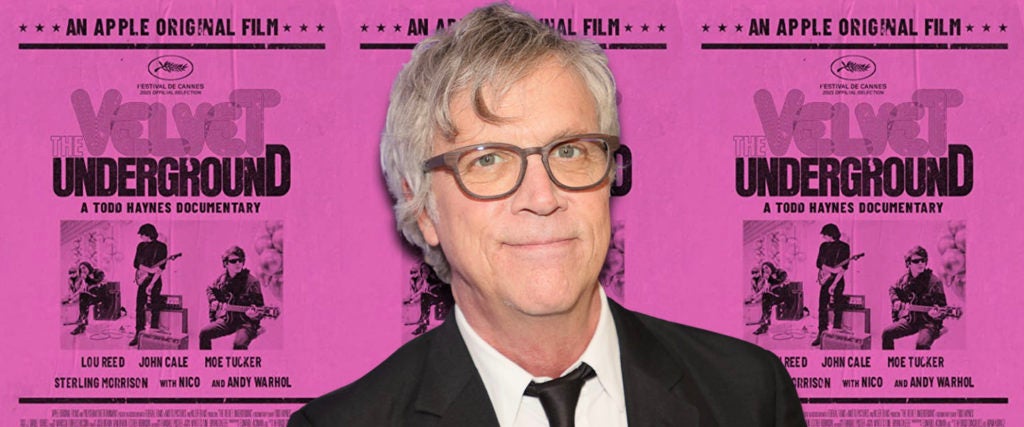Everybody at one point or another goes through a Velvet Underground phase — maybe even for life. Perhaps there are better bands — certainly there were ones who lasted longer — but this New York quartet have retained their status of the preeminent cool, outsider outfit since their first album, The Velvet Underground & Nico, hit stores in the spring of 1967. Other bands were more popular, but few have mattered as much as the Velvets, inspiring one of rock ‘n’ roll’s all-time great quotes, from musician/producer Brian Eno, who famously observed, “The Velvet Underground didn’t sell many records, but everyone who bought one went out and started a band.”
Led by the mercurial, brilliant frontman Lou Reed — and shepherded by tastemaker Andy Warhol, who was their early manager — the group made four albums before Reed walked away to pursue a solo career, leaving a legacy that remains one of the most important in all of rock history. Whether it’s the haunting addiction lament “Heroin,” the kinky S&M of “Venus in Furs,” the guitar-driven punisher “Sister Ray” or the tender “Pale Blue Eyes,” the Velvet Underground pursued a darker aesthetic both sonically and thematically than their peace-and-love hippie peers out in California, breaking down barriers in terms of sexual identity and subject matter.
Glam and punk are unthinkable without the Velvets — not to mention David Bowie, Joy Division and however you want to define modern indie-rock. (Everyone from St. Vincent to Kurt Vile contributed to a new collection of Velvet Underground & Nico covers.) But because the band were never superstars — because their songs aren’t played on the radio or show up in car commercials — they never got overexposed. They still sound fresh, always laying in wait for a new generation to discover them.
Todd Haynes fell in love with the Velvet Underground in college. In this band — which at their peak included Reed, drummer Moe Tucker, bassist/viola-player John Cale and guitarist Sterling Morrison — the aspiring filmmaker (who turns 61 early next year) found a subversive energy that spoke to his own desires to create art away from the mainstream. All he’s done is gone on to produce a singular body of work, starting with his 1987 short Superstar: The Karen Carpenter Story and then proceeding to envelope-pushing indie dramas such as Poison and Safe, later earning some of his best reviews for the Oscar-nominated Far From Heaven and Carol. In between, he’s directed experimental pseudo-biopics of foundational musical influences, first with the glam-rock tribute Velvet Goldmine and later with I’m Not There, his bold dissection of Bob Dylan’s different musical personae.
But now Haynes is paying homage to the band that originally lit his fuse, delivering The Velvet Underground (available today in theaters and on Apple TV+), his first documentary, which is a typically ambitious and challenging film that tells the band’s story through split-screens, a few on-camera interviews and an immersive overview of the Velvets in their particular time and place — specifically, the 1960s New York underground art scene. This isn’t Behind the Music, although we hear about some of the feuds and ego clashes. Rather, Haynes has created a cinematic equivalent of the band’s enrapturing, evocative music: The Velvet Underground is as poetic, sexy and no-bullshit as the group itself.
I spoke to Haynes this week about the Velvets’ lasting influence — in particular, their crucial contribution to rock’s history of sexual and gender fluidity. But he was also keen to discuss the eternal mystery of Lou Reed, who aspired to be a rock star and refused to be pinned down to any sexual orientation throughout his long career.
In your director’s statement in the press notes, you write, “As a young gay guy I didn’t have to read Lou Reed’s lyrics … to recognize the world being conjured in this music: its erotic charge and its drive came from its assertion of marginality.” How did that erotic charge shape you as a college student getting into the band?
Hearing their music, I think of it almost like you’re entering a space that’s intact, that’s separate from the rest of the world — you’re walking into this place. I don’t know if it’s going into an interior or an exterior, but it’s a place where there’s a great sense of expressing one’s sense that the world isn’t all right — and yet, using that as a permission to speak and be heard. To me, it was inherently a creative kind of invitation that said, “Yeah, you too can express your experience.”
There was some link I felt between that sense of creativity and transgression that was in the music, but it also made me think that maybe creativity itself — when it really is plummeting into something meaningful — is also partly transgressive. But it’s not necessarily a healthy enterprise — you have to get into the dirt a little bit to pull out something of meaning.
The kinds of artists that I was finding myself getting attracted to — and the Velvets were part of this — were artists that were exploring those kinds of territories. And it’s sort of general to speak that way, but you’re talking about the feeling you have when you listen to music, which is very subjective. But it definitely felt like a clear message — and one that was beckoning and opened a door for me.
Early in The Velvet Underground, you include an interview with one of Reed’s childhood friends talking about how he always said he wanted to be a rock star. I love the Velvet Underground, but it’s impossible to imagine them ever being that successful — that juxtaposition between Reed’s ambitions and the band’s limited commercial reach is really striking.
It’s one example of contrary and conflicting instincts and aspects of this artist and of this man — they were pulling him sometimes one way and sometimes the other, but they didn’t really go away. A desire for some level of success was something that was pulling him along, and at one point one could say, “Oh wow, when Andy Warhol beckons and says, ‘Come join us, I’m going to put you on the stage and throw my movies on you and make a spectacular multimedia event out of your music and you,’ that was a level of success for this guy who hadn’t even imagined being in that place.”
But after a while, that too became a way of marginalizing what he was able to do in his music. And I think it ultimately became like, “No, I don’t want to be part of the Andy Warhol carnival anymore, and I need to step away from that. At some point, I need to push away this other incredibly strong creative partner in order to further my own creative growth.”
Whether that’s sometimes instinctive and hostile and he takes it back later or feels regret about it, none of us can say. You can hear the retribution that he feels toward how he pushed Andy Warhol away in Songs for Drella in those songs of contrition and apology that he is making to Andy. So you see somebody reckoning with the casualties of his moods and his defenses. I think that was a lifelong process that he underwent — and so much was produced in the process creatively.

At different times of his career, Reed would say he was straight or gay or bisexual or pansexual. The documentary doesn’t answer that mystery — how interested were you in dissecting his different sexual identities?
I was interested in that part of his life. But I wasn’t interested in reducing down the larger sense of a kind of queer outlook — for lack of a better word — that we have today, this sort of revisionist language about this pre-Stonewall time, into whether he was literally having sex with guys or not. Or who was or who wasn’t. It was bigger than that.
In the film, when [the Velvets] went [on tour] to the West Coast, [there’s] an amusing sort of clash of subcultures that happened, but it’s why [Warhol superstar] Mary Woronov would say in a quote I love, making a litany of how different they were than the West Coast hippies, she ended by saying, “They were homophobic, we were homosexual.” And, of course, she didn’t mean that she was a lesbian, because she wasn’t — it was more like she assumed this attitude and this framework for how you look at the rest of the world, even when it’s the countercultures of that time. “No, you know what? We stand for something else.”
It’s that “something else” that I was really interested in trying to hear people describe who I interviewed and really understand as something that was definitive for this time — and, without which, this band wouldn’t be who they are.
The 1960s rock ‘n’ roll scene before the Velvets really practiced a heteronormative brand of sexual liberation. But this band pushed that envelope, suggesting a glimmer of something beyond that.
It’s not just the glimmer of something else — it’s a fucking ramrod of something else. But it’s linked to an outlook on the world and on what it means to live in the world and how vulnerable we all might feel in the world.
The 1960s sort of ethos, for the most part, was about affirmation, self-realization, visionary language, and it produced so many extraordinary artists who were different manifestations of all of that. And, of course, that was needed and radical for Bob Dylan and the Stones and the Beatles and Aretha and Miles Davis — it’s still mind-blowing. But the Velvets were talking about something else. They were talking about something that was counter-affirmative — it was about that marginality. And it was about sometimes feeling like you want to nullify your life. And what do you do with that feeling? Where does that feeling go? And what does that feeling produce? And that’s something that they could share as a band.
Your film goes beyond the band’s music, showing how the New York underground art scene as whole — whether it’s film or visual art — was doing something very different than the mainstream. I almost felt like you were saying, “This whole world existed, and it hasn’t been given its due.”
Oh, absolutely, it was essential. The reason why it was important to try to lean into these things we’re talking about in this film is that, however long it took, the band now enjoys the canonization that was so long deferred to them. Yes, they’re a massive influence, and they opened the door for all of these other genres of music that, really, it’s hard to imagine existing without [the Velvet Underground] — whether it’s glam rock or punk rock or grunge or whatever. But how they stood apart [at that time] might have gotten lost.
Today, everything gets absorbed and consumed within a corporate model — everything can be incorporated or appropriated. Well, they were not appropriated — no one knew how to appropriate them. And there’s a force in that. They also performed a kind of resistance to this incredibly infectious and inspiring culture that was all around in music, even if it was slightly feigned. They were very interested in what Bob Dylan was going to do next, but they had to say, “Oh, fuck that guy.” And that as a creative instinct — it’s really, really important to reject what’s around you, just to set up those obstacles.
You’ve mentioned that you view The Velvet Underground as a prequel of sorts to Velvet Goldmine, which was a fictionalized account of the 1970s glam-rock scene. Obviously, David Bowie and Lou Reed had such a connection, especially in terms of how they played with sexual identity.
And it’s alluded to in Velvet Goldmine — it’s part of the romance that the Bowie-esque character Brian Slade feels for the embodiment of the American, hard-rock Raw Power figure, who is in that Curt Wild character. Really, that Curt Wild character, although he looks and borrows a lot from the look of Iggy Pop, he really, in terms of the relationship and the sort of romance between the two, I think owes way more to Lou Reed. That was always an amalgam for me — in the concept, he was always an amalgam of the two.
But it wasn’t until Bowie was that person who was experimenting with pantomime and music-hall music and Anthony Newley and all that stuff — it wasn’t until he found that darker root musically and culturally, or in evoking something dark and primal, it wasn’t until that force met with the camp, British thing — that Ziggy Stardust was born. He needed that bottom. He needed that force, that corrosive element, and that came from what the Velvets were doing.
But the Velvets were also exploring sexuality, and Iggy Pop was deconstructing masculinity and turning into a masochistic sort of figure. So masculinity was being overturned or exploded by all of these artists, as Baudelaire started to do with the dandy and Warhol was doing with popism and the camp ideology of the 1960s. So there’s a continuum there, but it really needed the Velvets. There’s no way any of it could have happened without the Velvets — except maybe Baudelaire. [Laughs]

The Velvet Underground have always remained cool — there was never any period after they dissolved that they weren’t considered hip. And I wonder if in our current society, where masculinity and gender are so fluid, if the Velvet Underground do still speak to young people. Those labels aren’t as important as they used to be, and watching the movie, I was thinking if I was 16 and questioning gender or sexuality, the band would completely appeal to me. It just feels like they’re such a welcoming influence for any young person who’s trying to find themselves.
I would love that to be the case. You don’t really know. I think, on the one hand, there is of course fluidity in a new kind of acceptance about trans identity and LGBTQ culture and all of that. There’s also in some ways — and it’s even embedded within some of that — a more essential view of identity as predetermined in something you have to find and cling to that doesn’t feel fluid. It feels rigid in a way. It feels like everybody has to claim their identity root and hang onto it and say, “This is who I am, and I have this experience that’s completely distinct from your experience.”
So I’d love some of that fluidity to be at least considered again, because I think certain climates of fear force us to cling to our differences and hang on to them and become more fundamentalist about what they mean. And when you look around today, there’s a lot of that — not just on the right, but sometimes on the left as well.
Lou Reed died years before you started The Velvet Underground. While making the film, did you find yourself really wishing you could ask him one question in particular?
I can’t think of one burning, lingering question. The process of a documentary — from my one experience and from what I’ve observed in other docs — is a fluidity and a flexibility. You have to be open to what you get — you might think your story’s about this, and then in the process of making it, it becomes something else. And if you’re not listening to that, you’re not really allowing the process to determine the result.
What I would’ve loved is to have just spent some time with him. And what I learned in my interview process — [journalists] know this more than I do — is you come prepared, you have your notes, you have your research, but the interview, when it’s best, is going to move in some other direction, and it [won’t] necessarily follow what you plan for. What I would’ve loved is to have been surprised by where Lou might have taken us — even in my expectations or the questions I wanted to ask him.
He was a missing thing, but it’s okay — that’s just the condition under which we made this movie. He was a structuring absence. There’s a sense of longing for him in the film and the fact that you’ll never solve the Lou Reed mysteries. And that’s also essential to the glamour of this music and what it continues to conjure in you when you submit to it.

